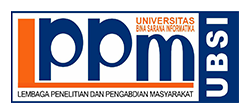Quality Analysis of the BNI Mobile Banking Application for Customers Using Webqual 4.0
DOI:
https://doi.org/10.31294/p.v25i1.1723Keywords:
Analysis of Quality, BNI Mobile Banking, Webqual, SPSS ApplicationAbstract
PT. Bank Negara Indonesia (Persero) Tbk. is a bank institution owned by the government of the Republic of Indonesia or better known as a state-owned company. In today's digital era, online services are the choice of most customers. This is because all types of banking transactions can be done easily. With the inclusion of smartphones as the devices most needed by the public at this time, BNI offers a mobile banking service called BNI Mobile Banking. This study will measure the quality of the BNI Mobile Banking application through the Webqual dimensions (usability, information quality, interaction quality) and the variable user satisfaction, namely BNI KCU Bogor customers. The data collection method uses primary data in the form of questionnaires distributed to 100 respondents. Data processing is done using SPSS. Based on data processing, it can be seen that the user's perception of ease of use, quality of information, quality of interaction is included in the very good category. Based on the results of the study, it was found that there was only an effect of usability and information quality and no effect of interaction quality on user satisfaction for BNI KCU Bogor customers. From the research results, it can be seen that the information quality variable contributes the largest contribution, namely 94.75% of the other variables
Downloads
Published
How to Cite
Issue
Section
License
Copyright (c) 2023 Yuni Eka Achyani, Yehezkiel Hardy Saputra

This work is licensed under a Creative Commons Attribution-ShareAlike 4.0 International License.
Paradigma is an open-access article distributed under the terms of the Creative Commons Attribution-ShareAlike 4.0 International License (https://creativecommons.org/licenses/by-sa/4.0/) , This license permits: Share — copy and redistribute the material in any medium or format for any purpose, even commercially, Adapt — remix, transform, and build upon the material for any purpose, even commercially.




















 Jl. Kramat Raya No.98, Kwitang, Kec. Senen, Kota Jakarta Pusat, DKI Jakarta 10450
Jl. Kramat Raya No.98, Kwitang, Kec. Senen, Kota Jakarta Pusat, DKI Jakarta 10450
